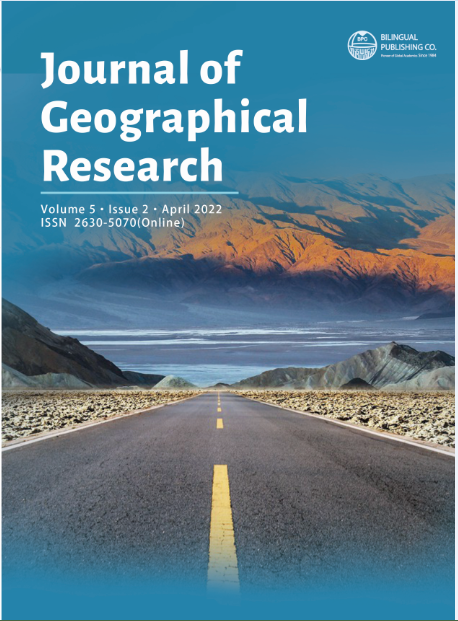-
11567
-
1938
-
1850
-
1712
-
1393
Open Space Implications in Urban Development: Reflections in Recent Urban Planning Practices in Nepal
DOI:
https://doi.org/10.30564/jgr.v5i2.4544Abstract
Open space has various implications in urban development planning and has been integrated in recent urban planning approaches and practices in Nepal. The open spaces are not only important for (re)shaping the urban form but are also important for enhancing urban social life and disaster risk management, particularly for dense cities. As most of the cities in Nepal have been growing haphazardly, the cities lack sufficient open space. However, the value of open space in dense cities like Kathmandu has been recognized more after the Gorkha Earthquake 2015 as the open spaces were extensively used for risk relief, treatment, recovery, and rehabilitation during and after the earthquake. With this background, this paper presents the major planning initiatives in Nepal and discusses how recent urban plans have provisioned and initiated open spaces development by reviewing concurrent urban planning practices, particularly reviewing Periodic Plans, Integrated Urban Development Plan, Smart City Plan, and Land Development Plan. The development of open areas has not been given much attention in the earlier urban planning practice but recent urban development planning has emphasized with a special focus which is very important for sustainable and safer city development and is expected to address the current bulging urban issues of spatiality and sociability. Therefore, it is very important for integrating open space implications in city planning and such open space should be conceptualized according to the city’s geography, landscape as well as socio-cultural contexts.
Keywords:
Open space, Urban development, Planning practices, Land developmentReferences
[1] Tiwari, S.R., 1989. Tiered temples of Nepal. Sunita Tiwari Publication: Kathmandu.
[2] Chitrakar, R.M., 2015. Transformation of public space in contemporary urban neighbourhoods of Kathmandu valley, Nepal: an investigation of changing provision, use and meaning. (Ph.D. Thesis), School of Civil Engineering and Built Environment Faculty of Science and Engineering Queensland University of Technology.
[3] KVDA, 2015. Atlas of open space. KVDA, Kathmandu.
[4] UN-Habitat, 2018. Developing public space and land values in cities and Neighborhoods (discussion paper). Kathmandu: UN-Habitat.
[5] Wooley, H., 2003. Urban open space. London and New York: Tailor and Francis.
[6] KMC, 2011. Periodic plan of Kathmandu Metropolitan City. Department of Urban Development and Building Construction, Kathmandu.
[7] Timalsina, K.P., 2020. Public open space in crises:Appraisal and observation from metropolitan Kathmandu. Journal of Geography and Regional Planning. 13(4), 77-90.DOI: https://doi.org/10.5897/JGRP2020.0797
[8] Shrestha, S.R., Sliuzas, R., Kuffer, M., 2018. Open spaces and risk perception in post-earthquake Kathmandu city. Applied Geography. ELSEVEIR: Amsterdam. 93, 81-91.
[9] NTPCO, 2019a. Preparation of Smart City for Developing Nijgadh as a Smart City. NTPCO (DUDBC), Babarmahal, Kathmandu.
[10] NTPCO, 2019b. Preparation of Smart City for Developing Lumbini as a Smart City. NTPCO (DUDBC), Babarmahal, Kathmandu.
[11] Poudel, K., 2017. Open space vanishing fast. New spotlight magazine. 11, 08.
[12] MoFAGA, 1999. Local Self Governance Act, Kathmandu: MoFAGA.
[13] MoFAGA, 2000. Local Self Governance Regulation, Kathmandu: MoFAGA.
[14] ADB, 2020b. Guidelines for preparation of Integrated Urban Development Plan (Draft). ADB, A-9384 NEP: Regional Urban Development Project. Kathmandu: DUDBC.
[15] DUDBC, 2020. Preparation of Integrated Urban Development Plan of Various Municipalities. DUDBC: Kathmandu.
[16] NTPCO, 2020a. Preparation of Smart City for Developing Chandrapur as a Smart City. NTPCO (DUDBC), Babarmahal, Kathmandu.
[17] NTPCO, 2020b. Preparation of Smart City for Developing Dullu as a Smart City. NTPCO (DUDBC), Babarmahal, Kathmandu.
[18] ADB, 2020a. Land pooling in Nepal from planned urban “islands” to city transformation. ADB South Asia Working Paper Series, ADB: Manila, Philippines.
[19] ADB, 2017. Land pooling projects in Nepal: A consolidated document. Regional - Capacity Development Technical Assistance (R-CDTA), ADB/OIE, Kathmandu.
[20] MoUD, 2015. Planning Norms and Standards. DUDBC, MoUD: Kathmandu.
[21] Bhadrapur Municipality, 2017. Integrated Urban Development Plan of Bhadrapur Municipality. Bhadrapur, Jhapa.
[22] DUDBC, 2015. Physical development plan and GIS based base map of Lamahi TDC area, Dang. DUDBC: Kathmandu.
[23] DUDBC, 2018. Preparation of Integrated Urban Development Plan of Dudhauli Municipality, Sindhuli District, DUDBC: Kathmandu.
[24] French, E.M., 2017. Designing public open space to support seismic resilience: A systematic review. Master’s Thesis (unpublished), The University of Guelph, Ontario, Canada.
[25] Koren, D., Rus, K., 2019. The potential of open space for enhancing urban seismic Resilience: A literature review. Sustainability, MDPI. 11.DOI: https://doi.org/10.3390/su11215942
[26] NRA, 2016. Nepal earthquake 2015: Post-disaster recovery framework, 2016-2020. Kathmandu: National Reconstruction Authority, Government of Nepal.
[27] Pelling, M., 2003. The vulnerability of cities: Natural disasters and social resilience. London: Earthscan.
[28] USAID, 2010. Planning for disaster risk reduction, urban governance and community resilience guidelines. USAID, Asian Disaster Preparedness Center (ADPC).
[29] https://www.newsghana.com. and https://www.theatlantic.com (Accessed on 22 May 2020)
Downloads
How to Cite
Issue
Article Type
License
Copyright © 2022 Krishna Prasad Timalsina, Bhim Prasad Subedi

This is an open access article under the Creative Commons Attribution-NonCommercial 4.0 International (CC BY-NC 4.0) License.




 Krishna Prasad Timalsina
Krishna Prasad Timalsina





